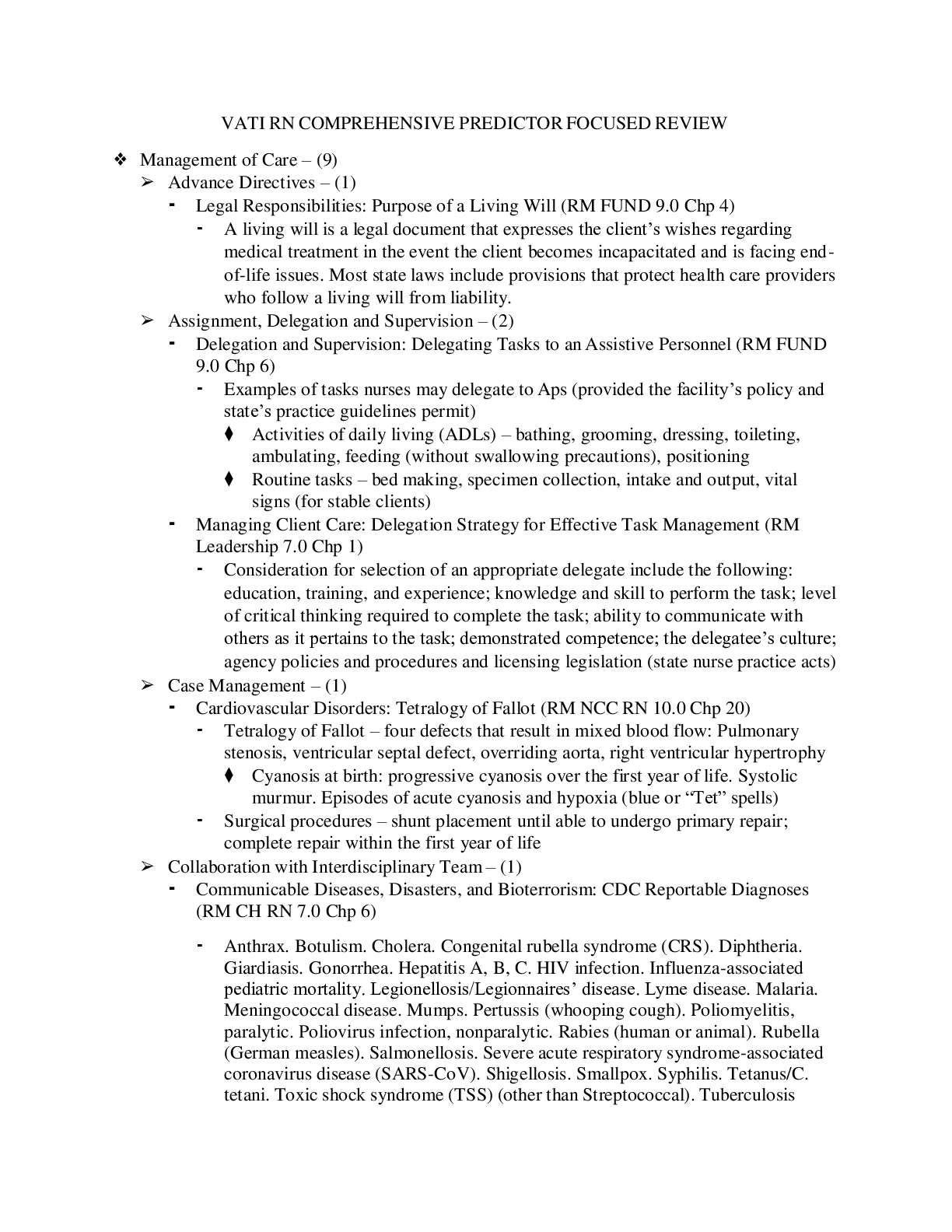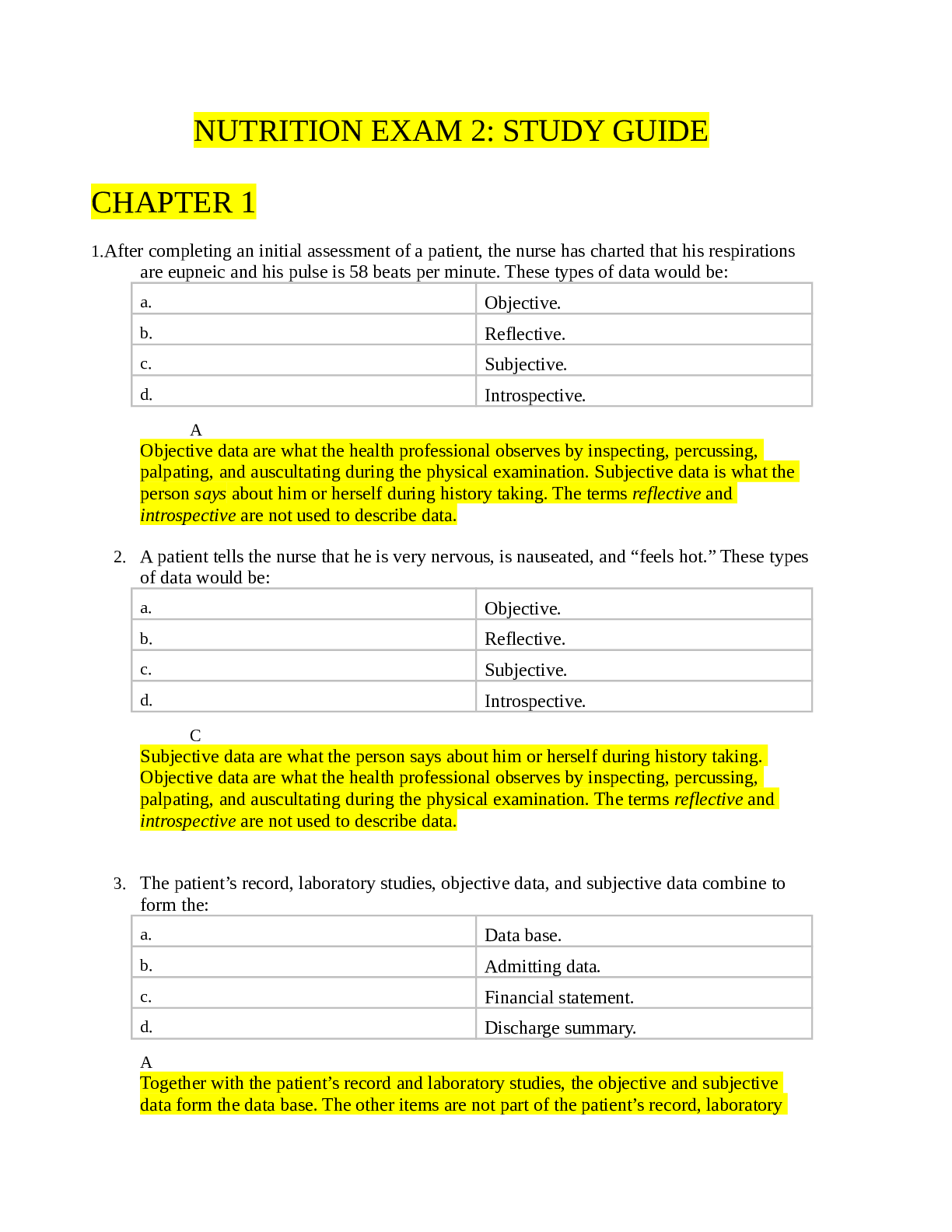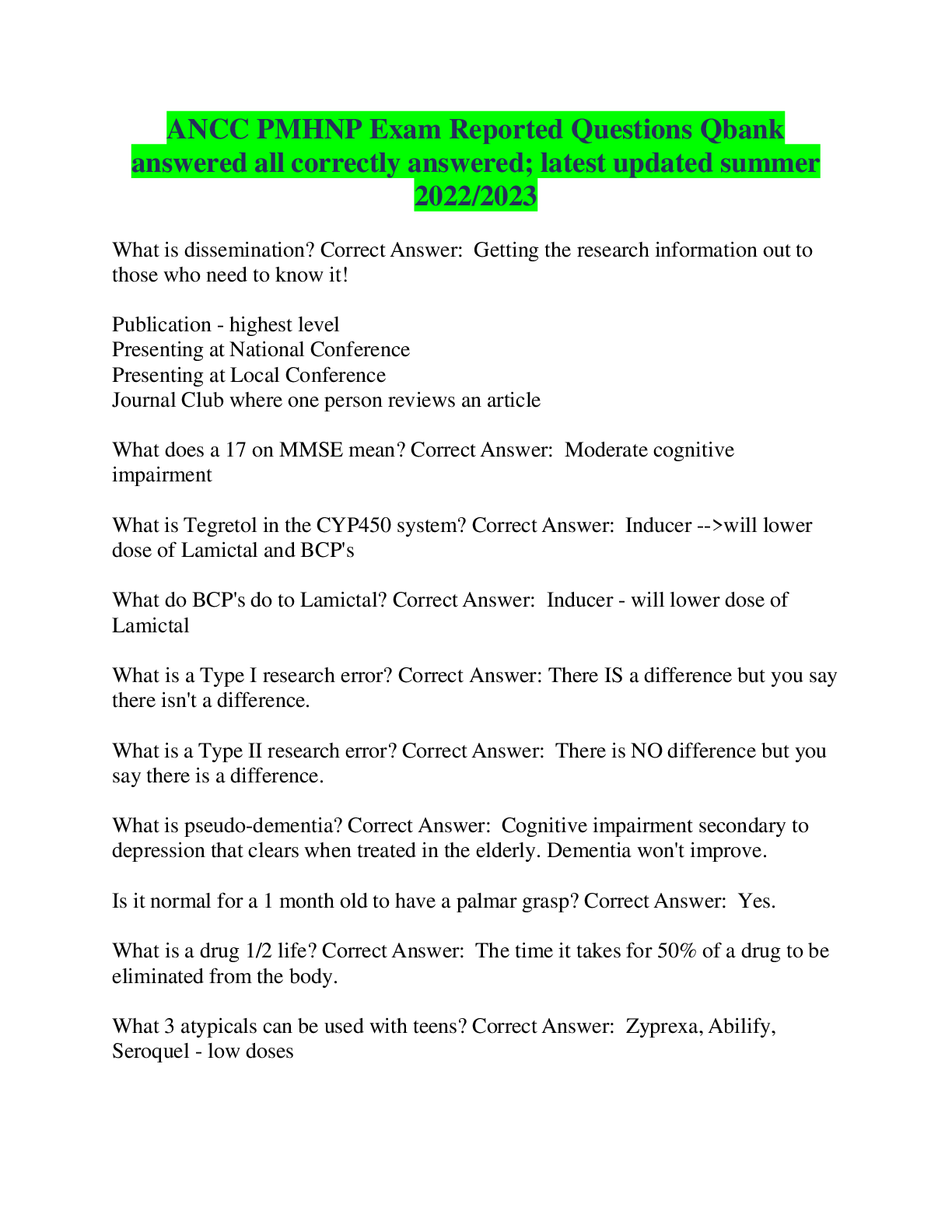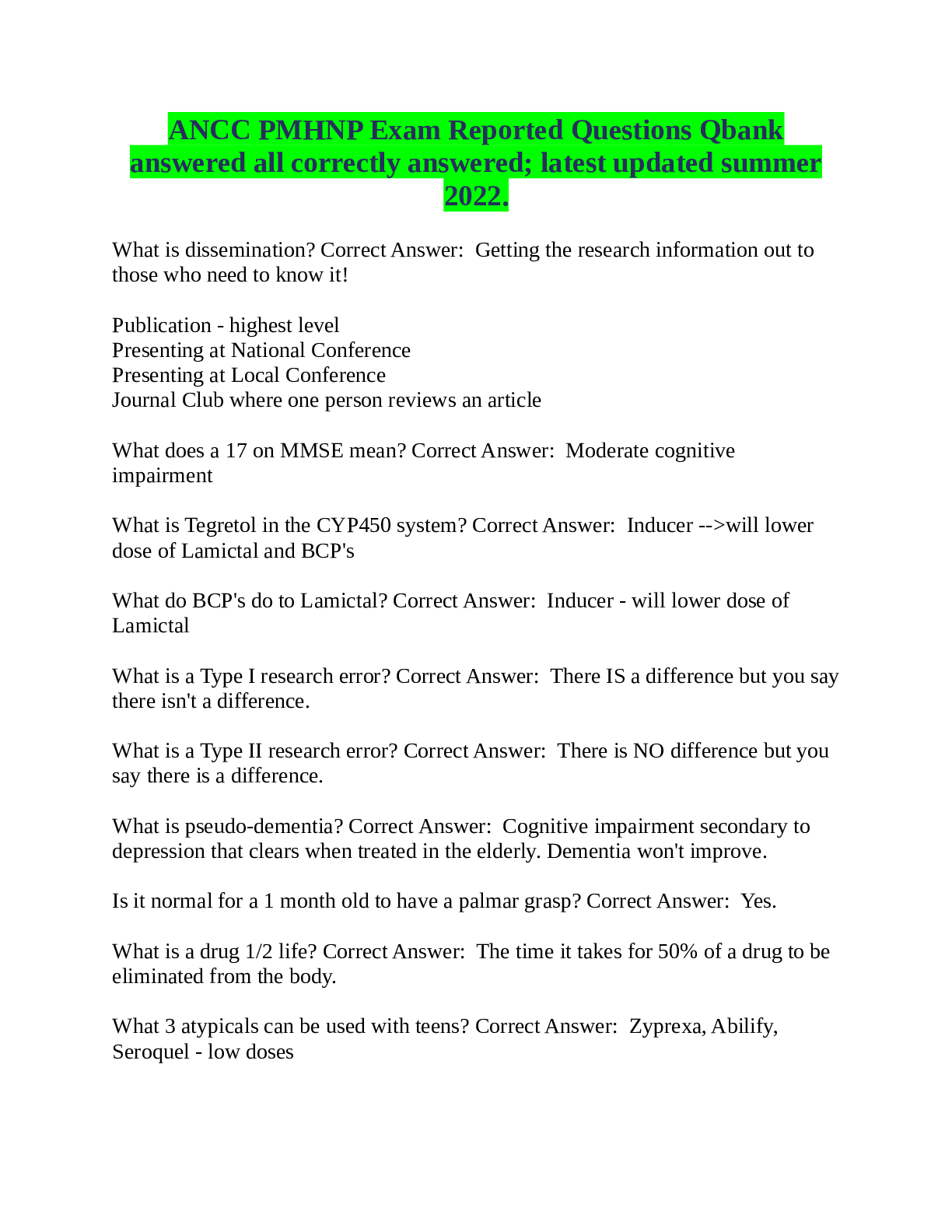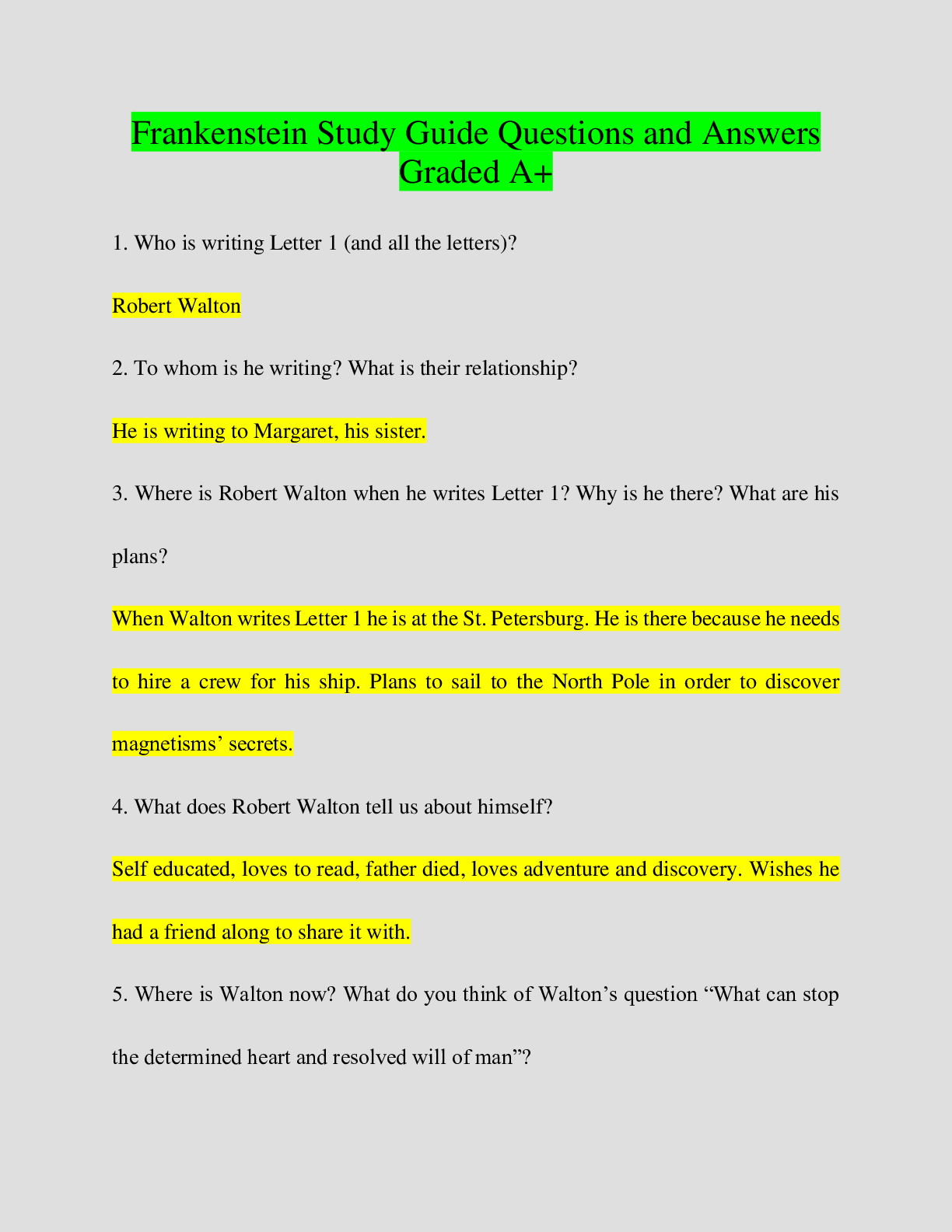*NURSING > EXAM REVIEW > Chapter 10 & 11 together:Health Assessment Exam 2: Study Guide Questions All correctly Answered and (All)
Chapter 10 & 11 together:Health Assessment Exam 2: Study Guide Questions All correctly Answered and with Explanations.Download to score A.
Document Content and Description Below
1. When evaluating a patient’s pain, the nurse knows that an example of acute pain would be: a. Arthritic pain. b. Fibromyalgia. c. Kidney stones. d. Low back pain. C Acute pain is short-term... and dissipates after an injury heals, such as with kidney stones. The other conditions are examples of chronic pain during which the pain continues for 6 months or longer and does not stop when the injury heals. 2. Which statement indicates that the nurse understands the pain experienced by an older adult? a. “Older adults must learn to tolerate pain.” b. “Pain is a normal process of aging and is to be expected.” c. “Pain indicates a pathologic condition or an injury and is not a normal process of aging.” d. “Older individuals perceive pain to a lesser degree than do younger individuals.” C Pain indicates a pathologic condition or an injury and should never be considered something that an older adult should expect or tolerate. Pain is not a normal process of aging, and no evidence suggests that pain perception is reduced with aging. 3. A 4-year-old boy is brought to the emergency department by his mother. She says he points to his stomach and says, “It hurts so bad.” Which pain assessment tool would be the best choice when assessing this child’s pain? a. Descriptor Scale b. Numeric rating scale c. Brief Pain Inventory d. Faces Pain Scale—Revised (FPS-R) D Rating scales can be introduced at the age of 4 or 5 years. The FPS-R is designed for use by children and asks the child to choose a face that shows “how much hurt (or pain) you have now.” Young children should not be asked to rate pain by using numbers. 4. A patient states that the pain medication is “not working” and rates his postoperative pain at a 10 on a 1-to-10 scale. Which of these assessment findings indicates an acute pain response to poorly controlled pain? a. Confusion b. Hyperventilation c. Increased blood pressure and pulse d. Depression C Responses to poorly controlled acute pain include tachycardia, elevated blood pressure, and hypoventilation. Confusion and depression are associated with poorly controlled chronic pain (see Table 10-1). 5. A 60-year-old woman has developed reflexive sympathetic dystrophy after arthroscopic repair of her shoulder. A key feature of this condition is that the: a. Affected extremity will eventually regain its function. b. Pain is felt at one site but originates from another location. c. Patient’s pain will be associated with nausea, pallor, and diaphoresis. d. Slightest touch, such as a sleeve brushing against her arm, causes severe and intense pain. D A key feature of reflexive sympathetic dystrophy is that a typically innocuous stimulus can create a severe, intensely painful response. The affected extremity becomes less functional over time. 6. The nurse is assessing a patient’s pain. The nurse knows that the most reliable indicator of pain would be the: a. Patient’s vital signs. b. Physical examination. c. Results of a computerized axial tomographic scan. d. Subjective report. D The subjective report is the most reliable indicator of pain. Physical examination findings can lend support, but the clinician cannot exclusively base the diagnosis of pain on physical assessment findings. 7. A patient has had arthritic pain in her hips for several years since a hip fracture. She is able to move around in her room and has not offered any complaints so far this morning. However, when asked, she states that her pain is “bad this morning” and rates it at an 8 on a 1-to-10 scale. What does the nurse suspect? The patient: a. Is addicted to her pain medications and cannot obtain pain relief. b. Does not want to trouble the nursing staff with her complaints. c. Is not in pain but rates it high to receive pain medication. d. Has experienced chronic pain for years and has adapted to it. D Persons with chronic pain typically try to give little indication that they are in pain and, over time, adapt to the pain. As a result, they are at risk for underdetection. 8. The nurse is reviewing the principles of pain. Which type of pain is due to an abnormal processing of the pain impulse through the peripheral or central nervous system? a. Visceral b. Referred c. Cutaneous d. Neuropathic D Neuropathic pain implies an abnormal processing of the pain message. The other types of pain are named according to their sources. 9. When assessing the quality of a patient’s pain, the nurse should ask which question? a. “When did the pain start?” b. “Is the pain a stabbing pain?” c. “Is it a sharp pain or dull pain?” d. “What does your pain feel like?” D To assess the quality of a person’s pain, the patient is asked to describe the pain in his or her own words. 10. When assessing a patient’s pain, the nurse knows that an example of visceral pain would be: a. Hip fracture. b. Cholecystitis. c. Second-degree burns. d. Pain after a leg amputation. B Visceral pain originates from the larger interior organs, such as the gallbladder, liver, or kidneys. 11. The nurse is reviewing the principles of nociception. During which phase of nociception does the conscious awareness of a painful sensation occur? a. Perception b. Modulation c. Transduction d. Transmission A Perception is the third phase of nociception and indicates the conscious awareness of a painful sensation. During this phase, the sensation is recognized by higher cortical structures and identified as pain. 12. When assessing the intensity of a patient’s pain, which question by the nurse is appropriate? a. “What makes your pain better or worse?” b. “How much pain do you have now?” c. “How does pain limit your activities?” d. “What does your pain feel like?” B Asking the patient “how much pain do you have?” is an assessment of the intensity of a patient’s pain; various intensity scales can be used. Asking what makes one’s pain better or worse assesses alleviating or aggravating factors. Asking whether pain limits one’s activities assesses the degree of impairment and quality of life. Asking “what does your pain feel like” assesses the quality of pain. 13. A patient is complaining of severe knee pain after twisting it during a basketball game and is requesting pain medication. Which action by the nurse is appropriate? a. Completing the physical examination first and then giving the pain medication b. Telling the patient that the pain medication must wait until after the x-ray images are completed c. Evaluating the full range of motion of the knee and then medicating for pain d. Administering pain medication and then proceeding with the assessment D According to the American Pain Society (1992), “In cases in which the cause of acute pain is uncertain, establishing a diagnosis is a priority, but symptomatic treatment of pain should be given while the investigation is proceeding. With occasional exceptions, (e.g., the initial examination of the patient with an acute condition of the abdomen), it is rarely justified to defer analgesia until a diagnosis is made. In fact, a comfortable patient is better able to cooperate with diagnostic procedures.” 14. The nurse knows that which statement is true regarding the pain experienced by infants? a. Pain in infants can only be assessed by physiologic changes, such as an increased heart rate. b. The FPS-R can be used to assess pain in infants. c. A procedure that induces pain in adults will also induce pain in the infant. d. Infants feel pain less than do adults. C If a procedure or disease process causes pain in an adult, then it will also cause pain in an infant. Physiologic changes cannot be exclusively used to confirm or deny pain because other factors, such as medications, fluid status, or stress may cause physiologic changes. The FPS-R can be used starting at age 4 years. 15. A patient has been admitted to the hospital with vertebral fractures related to osteoporosis. She is in extreme pain. This type of pain would be classified as: a. Referred. b. Cutaneous. c. Visceral. d. Deep somatic. D Deep somatic pain comes from sources such as the blood vessels, joints, tendons, muscles, and bone. Referred pain is felt at one site but originates from another location. Cutaneous pain is derived from the skin surface and subcutaneous tissues. Visceral pain originates from the larger, interior organs. [Show More]
Last updated: 1 year ago
Preview 1 out of 18 pages

Reviews( 0 )
Document information
Connected school, study & course
About the document
Uploaded On
May 09, 2021
Number of pages
18
Written in
Additional information
This document has been written for:
Uploaded
May 09, 2021
Downloads
0
Views
49



.png)


.png)
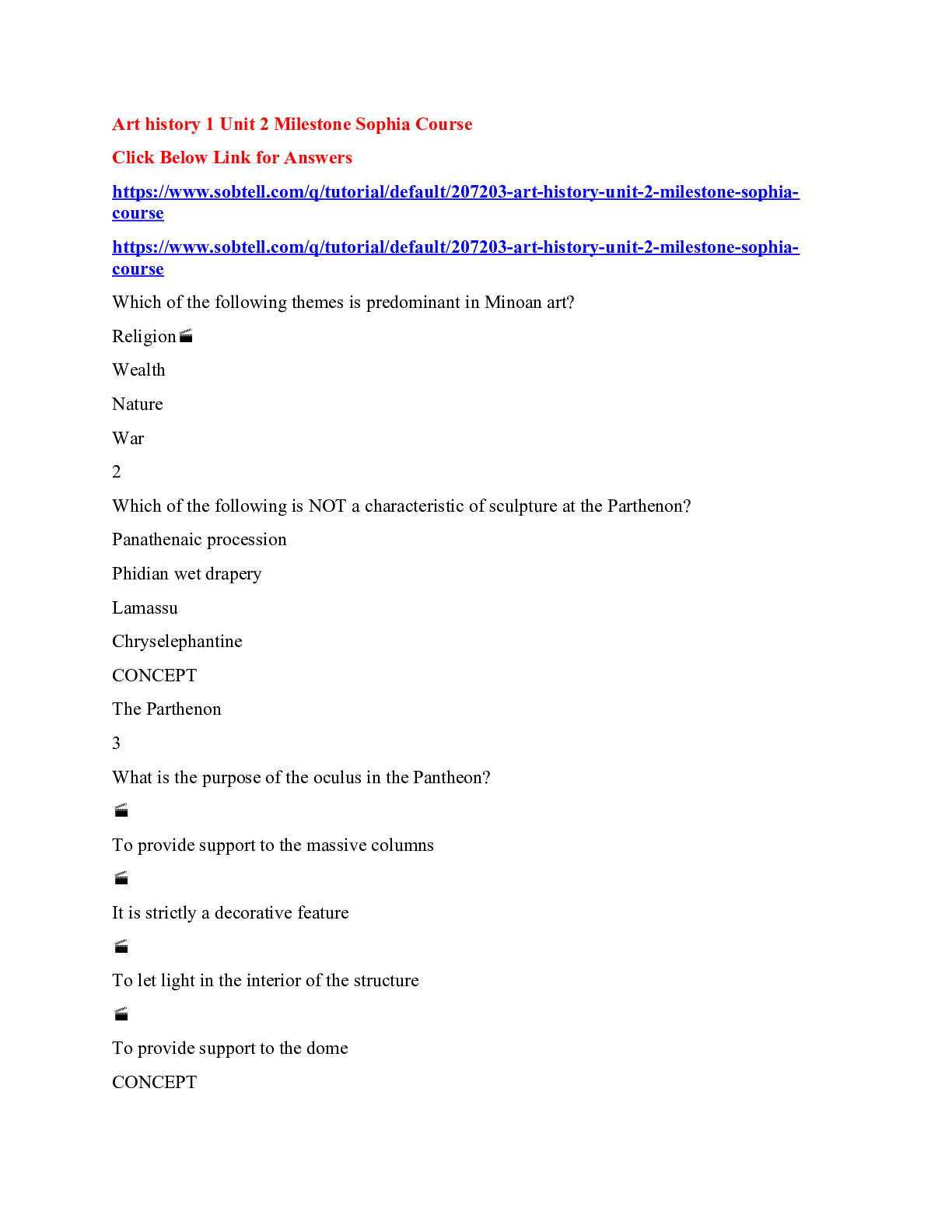




.png)
.png)



